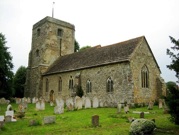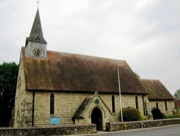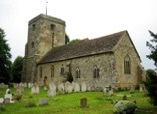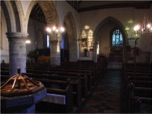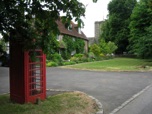Click on the above pictures for enlarged versions.
DESCRIPTION OF ST JOHN THE BAPTIST, KIRDFORD
Kirdford church was constructed to the north of the ford over the river on an area of raised land above flood level. It is a Grade 1 listed building and falls in the Kirdford Conservation Area, which is the oldest part of the village of Kirdford. According to 16th century wills the church was originally dedicated to Our Lady. The church is surrounded by a large churchyard which is still in use for burials. The walls are constructed of sandstone, probably from quarries at nearby Fittleworth, and the roof is mainly of Horsham stone slabs.
The church was probably first built in stone around 1100, as evidenced by Saxon-type herringbone masonry and a blocked Norman arched doorway on the south wall. (Click on “links” above for more information on these Romanesque features.) The interior is plastered and painted except for the pillars, arches and window outlines. The large north aisle was added in the 13th century and the chancel rebuilt in the 14th century with a vaulted sacristy. The west tower dates from the 15th century. Its ground floor was originally vaulted, but now has a flat ceiling created by the floor of the ringing chamber above. The porch has a medieval bargeboard and inverted Elizabethan balusters.
The Victorian era saw the installation of the organ and major alterations/restorations involving the floor, the pews, some external walls, the chancel arch, the removal of three wooden galleries, and the replacement of a wooden pulpit by one in stone. Four of the stained glass windows are by Kempe, produced between 1881 and 1907. (Click on “links” above for more details of these.) The Lady Chapel altar was moved from the east end of the north aisle to its present position in 1987 to create the choir vestry.
In 2013 two sets of glass doors were installed in the entrance area under the tower. They commemorate Queen Elizabeth’s Diamond Jubilee in 2012 and are engraved with an apple tree motif to reflect the apple-growing heritage of the village. At the same time a WC was installed in the entrance area and a kitchenette was placed at the rear of the north aisle.
The parish is noted for its Sussex marble and for its former glass making, examples of which may be seen in the church, notably the 17th century font which is constructed from marble, and the 13th century lancet window in the north wall which is glazed with fragments of local glass. The church holds a number of interesting fittings including the six bells (which are rung regularly), seven branched candelabra, two communion tables, two hatchments and some 16th century seating.
Click on the thumbnail pictures above for interior and exterior views of the church. For more information on the church, visit the websites listed under “links” above.
Kirdford church building
